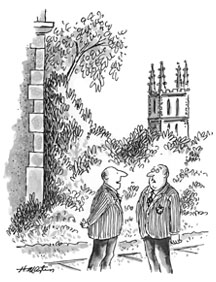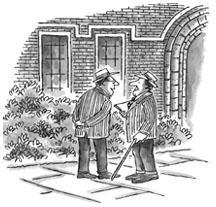July 2, 2003: Features

 Laughing,
gently, for half a century
Laughing,
gently, for half a century At Reunions and always, Henry Martin ’48 captures the “Flat Top” in all of us
By Mark Bernstein ’83
Photo: Henry Martin ’48 became an honorary member of the Class of 1998 at his 55th this year. (frank wojciechowski)
Even people who buy the New Yorker for its articles have to admit that when the magazine arrives, they first flip through to find the cartoons.
For 45 years, cartoonist Henry Martin ’48 drew many of those cartoons – occasionally with Princeton and Reunions themes – as well as illustrations for such national magazines as the Saturday Evening Post, Look, and Ladies’ Home Journal. For many years, he also drew a single-panel comic strip, “Good News/Bad News,” which ran in newspapers around the country.
After graduating from Princeton with a degree in art history, Martin went to art school in Chicago with the blessing of his father, a businessman, who “understood that I probably wouldn’t make it too well in the business world.” With little homework and a lot of free time, Martin began to send unsolicited sketches – used as filler – to magazines. For nine months he received nothing but rejection slips, until April 1950, when the New Yorker bought a tiny pen-and-ink sketch of a circus wagon for $20.
Though Martin continued to sell the occasional drawing, he supported himself and his family by taking a variety of art jobs, such as painting a mural on the wall of a Princeton gourmet shop. Ten years later, Martin sold his first cartoon to the New Yorker, and he focused his career in that direction. “I decided to give cartooning five years and if that didn’t work out I was going to – God forbid – get a job and go into business or something,” Martin says. By the end of those five years, Martin was selling cartoons regularly to national magazines.
Martin – who is now retired, though he continues to draw cartoons for PAW – says he always approached his job with discipline. He would arrive at his office on William Street in Princeton by 9 a.m. Mornings would be set aside for creative work; he would brainstorm and sketch at least five new ideas each day. After lunch, which sometimes included an informal “cartoonists round table” with local artists at the Annex, Martin spent his afternoons handling business correspondence.
Wednesdays were always “rounds day,” when Martin would travel to Manhattan to visit magazines to try to sell some of his cartoons. He and other cartoonists would sit with their portfolios in the New Yorker’s reception room and wait to be called by the art editor. Then they would watch nervously while the editor went through their week’s work.
Occasionally, the New Yorker would ask Martin to tweak a cartoon, and he would change a word here or a facial expression there. “I learned early on that a good editor can help you – and you get all the credit,” he laughs. He remembers one occasion, however, when the editorial process was more intimidating.
The art editor, Martin recalls, “got through with one of my cartoons and he didn’t say anything. And I asked, ‘Are there any changes?’ He looked up and said, ‘Make it funnier.’ ”
Martin insists that his jokes are better than his art. “Getting the ideas was the most fun for me,” he says. He describes a good cartoon as “a marriage of a good idea and a good drawing. A good idea can survive with a poor drawing, but not vice versa.”
The gentle, genial Martin draws mostly gentle people, many transparently upper-class and Ivy-educated, musing on the absurdities of this or that. Many of his beloved cartoons are set at Reunions, and of course a better theater of the absurd could hardly be found. In one, two paunchy, middle-aged men, both clad in ridiculous costumes, confront each other in a courtyard. In a flash of recognition that strips away the years, they call each other by their old nicknames: “Spooky!” “Flat Top!”
The appeal of Martin’s work lies in its simplicity, its universality,
and its affectionate appreciation for life, something that could touch
a nerve even in those who are not graying Princeton alums, and speak to
the inner Flat Top in all of us. ![]()
Mark Bernstein ’83 is a freelance writer and cartoonist.
Overheard at the 55th
By Henry Martin ’48

“Remember old Spooky and his roommate, Flat Top?”
“Good
God, man! I can’t even remember yesterday!”

“When did old Fairleigh start sporting an earring?”

“It sounds a bit silly, but last week I was checking out classmates in the new alumni directory when it slipped out of my hands and fell on my foot.”

“Well, we’ve all changed a lot since 1948 . . . new teeth, new valves, new hearts, new hips, new knees, and new wives.”
